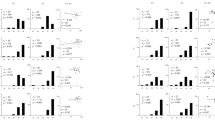Abstract
Pupation heights of various natural and laboratory populations ofDrosophila melanogaster, D. simulans, andD. pseudoobscura were observed in the laboratory under conditions of continuous darkness or continuous light. Generally higher mean pupation heights were observed under conditions of darkness.D. melanogaster tended to pupate higher than theD. pseudoobscura populations, andD. pseudoobscura tended to pupate higher thanD. simulans. The order of these species differences was similar whether pupation was measured in light or in darkness. Results of selection for pupation height inD. melanogaster suggest the presence of genetic variation for this character. The possibility that a relationship exists between adult and larval behaviors was explored by measuring the pupation heights of larvae from strains selected for geotactic behavior as adults, and also by measuring geotaxis of adults from strains selected for pupation height.
Similar content being viewed by others
References
Barker, J. S. F. (1971). Ecological difference and competitive interaction betweenDrosophila melanogaster andDrosophila simulans in small laboratory populations.Oecologia 8:139–156.
Demerec, M. (ed.) (1950).Biology of Drosophila, Hafner, New York.
De Souza, H. M. L., Da Cunha, A. B., and Dos Santos, E. P. (1970). Adaptive polymorphism of behavior involved in laboratory populations ofD. willistoni.Am. Nat. 104:175–189.
Dobzhansky, T., and Spassky, B. (1969). Artificial and natural selection for two behavioral traits inDrosophila pseudoobscura.Proc. Natl. Acad. Sci. 62:75–80.
Hirsch, J. (1959). Studies in experimental behavior genetics. I. Individual differences in geotaxis as a function of chromosome variation in synthesizedDrosophila populations.J. Comp. Physiol. Pschol. 52:304–308.
Pyle, D. W. (1976). Geotatic maze behavior inDrosophila melanogaster: A chromosomal analysis and a study of correlated responses to experimental selection. Ph.D. thesis, Arizona State University. Tempe.
Rizki, M. T. M., and Davis, C. (1953). Light as an ecological determinant of interspecific competition betweenDrosophila willistoni andDrosophila melanogaster.Am. Nat. 87:389–392.
Sameoto, D., and Miller, R. S. (1968). Selection of pupation site byDrosophila melanogaster andDrosophila simulans.Ecology 49:117–880.
Sokal, R. R. (1966). Pupation site differences inDrosophila melanogaster, Univ. Kans. Bull. 46:697–715.
Sokal, R., Ehrlich, P., Hunter, P., and Schlager, G. (1960). Some factors affecting pupation site ofDrosophila, Ann. Entomol. Soc. Am. 53:174–182.
Woolf, C. M., Sasmor, H., and Markow, T. (1978). Geopositive and geonegative behavior: Sex-linked traits inDrosophila pseudoobseura, Behav. Genet. 8:65–71.
Author information
Authors and Affiliations
Additional information
This work was supported by NIH Grant GM 19583.
Rights and permissions
About this article
Cite this article
Markow, T.A. A survey of intra -and interspecific variation for pupation height inDrosophila . Behav Genet 9, 209–217 (1979). https://doi.org/10.1007/BF01071301
Received:
Accepted:
Issue Date:
DOI: https://doi.org/10.1007/BF01071301




